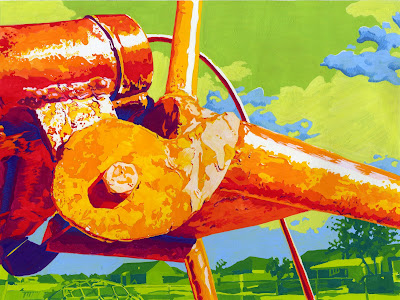 |
| Mid-Twentieth Century American Playground 4 Matthew D. Hughes Gouache on Bristol 9 1/2 x 12 1/2 inches 2011 |
This painting represents a stylistic turning point for my work.
During the 2011 Fall semester, I was taking an Art of Journaling class in addition to Color Theory. The Art of Journaling class was designed to develop one's skills at perceptually documenting experiences through sketching. Through this class, I discovered my love to work with hatching.
Hatching is a linear style of creating volume and value through the building up of parallel lines. Another style of linear modeling is cross-hatching where the lines are allowed to intersect. Similar to regular hatching is cross-contour hatching which also uses lines that run parallel to each other, but instead all the lines going the same direction, the line work follows the contours of the object they are describing. The regular, parallel hatching is the style which I have adopted for my own. Not only was hatching preferred by Renaissance artists for its ability to describe the volume of a subject rather than it's texture, but it is also a fast method to work with while sketching. This assignment required a linear application. Naturally, I gravitated to my new-found love of hatching.
This painting represents Johannes Itten's warm/cool color contrast. Compositions that are dominantly blue and red are typically warm/cool contrast. However, hues such as blue-green and red-orange can also demonstrate warm/cool contrast. The thing to remember about warm/cool contrast is that it must feel warm in some places and cool in other places. Warm areas will contain any of the hues from the warm side of the color wheel--yellow, yellow-orange, orange, red-orange, red, red-violet. Cool areas will contain any of the hues from the cool side of the color wheel--violet, blue-violet, blue, blue-green, green, yellow-green. This painting is a good example of warm/cool contrast because one can feel the heat of the areas that are hit by the direct light. Conversely, the areas that are in shadow actually feel cool, as if one can escape the heat by retreating to that shadow.
During the 2011 Fall semester, I was taking an Art of Journaling class in addition to Color Theory. The Art of Journaling class was designed to develop one's skills at perceptually documenting experiences through sketching. Through this class, I discovered my love to work with hatching.
Hatching is a linear style of creating volume and value through the building up of parallel lines. Another style of linear modeling is cross-hatching where the lines are allowed to intersect. Similar to regular hatching is cross-contour hatching which also uses lines that run parallel to each other, but instead all the lines going the same direction, the line work follows the contours of the object they are describing. The regular, parallel hatching is the style which I have adopted for my own. Not only was hatching preferred by Renaissance artists for its ability to describe the volume of a subject rather than it's texture, but it is also a fast method to work with while sketching. This assignment required a linear application. Naturally, I gravitated to my new-found love of hatching.
This painting represents Johannes Itten's warm/cool color contrast. Compositions that are dominantly blue and red are typically warm/cool contrast. However, hues such as blue-green and red-orange can also demonstrate warm/cool contrast. The thing to remember about warm/cool contrast is that it must feel warm in some places and cool in other places. Warm areas will contain any of the hues from the warm side of the color wheel--yellow, yellow-orange, orange, red-orange, red, red-violet. Cool areas will contain any of the hues from the cool side of the color wheel--violet, blue-violet, blue, blue-green, green, yellow-green. This painting is a good example of warm/cool contrast because one can feel the heat of the areas that are hit by the direct light. Conversely, the areas that are in shadow actually feel cool, as if one can escape the heat by retreating to that shadow.






